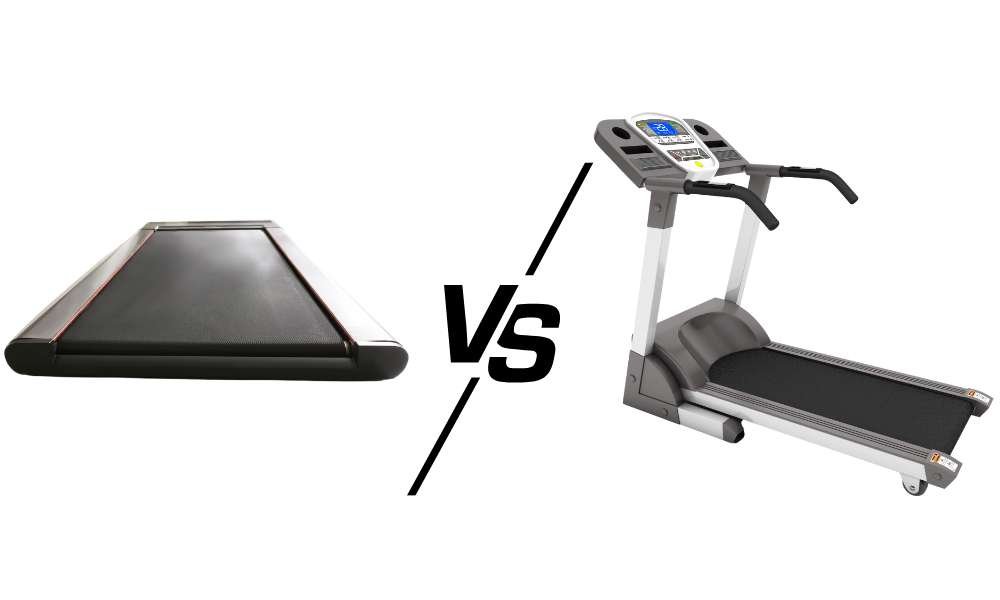The debate between the Walking Pad VS Treadmill comes down to space, functionality, and fitness goals. Both options provide a way to stay active, but they serve different purposes. A walking pad is a compact, space-saving solution designed for light activity, making it ideal for home offices and casual movement. On the other hand, a treadmill offers a more intense workout experience, supporting running, incline training, and structured exercise programs. This comparison will explore the key differences in design, features, usage, durability, health benefits, and cost to help you decide which option best fits your lifestyle.
Pros & Cons Summary (Walking Pad VS Treadmill)
| Feature | Walking Pad ✅ | Treadmill ✅ |
| Pros | Space-efficient, foldable, quiet, easy to use, affordable, low maintenance. | Versatile, supports walking/jogging/running, better for fitness, durable, more workout features. |
| Cons | Limited speed, not suitable for running, lower weight capacity. | Bulky, expensive, requires more space, higher maintenance needs. |
Design & Size
The design and size of a Walking Pad VS Treadmill cater to different needs and environments. A walking pad is compact, foldable, and specifically designed for small spaces, making it an excellent option for apartments, home offices, or rooms with limited space. It can easily be stored under a desk, bed, or couch when not in use, allowing for a clutter-free living area. Due to its lightweight build, it is also easy to move around and reposition as needed. In contrast, a treadmill is bulkier and requires a dedicated space for setup.
Traditional treadmills feature a larger running deck, a heavy-duty frame, and additional functionalities like incline adjustment and shock absorption, which make them significantly larger and heavier. While treadmills provide more stability and durability, they are not as convenient for those with space constraints. Choosing between the two depends on how much space is available and how easily the equipment needs to be stored or moved.
Functionality & Features
When comparing functionality and features, Walking Pad VS Treadmill serve different purposes based on activity level and fitness goals. A walking pad is designed primarily for low-speed movement, making it ideal for casual walking, light exercise, or staying active while working at a standing desk. It typically has a speed range of 0.5 to 4 mph, preventing jogging or running but encouraging consistent movement throughout the day. Many walking pads come with remote controls or app connectivity for easy adjustments, but they lack advanced features like incline settings or built-in workout programs. In contrast, a treadmill offers a wider speed range, typically from 0.5 to 12 mph, allowing users to walk, jog, or run at varying intensities.
Many treadmills include incline adjustments, pre-set workout programs, heart rate monitors, and shock-absorbing decks to enhance workout effectiveness. These added features make treadmills a better choice for serious fitness training, weight loss, and endurance building, whereas walking pads are best for maintaining a more active lifestyle with minimal impact.
Usage & Purpose
The intended usage and purpose of a walking pad and a treadmill differ significantly based on lifestyle and fitness goals. A walking pad is best suited for home offices, multitasking, and casual movement throughout the day. It is an excellent choice for individuals who want to stay active while working at a standing desk, watching TV, or engaging in light activities. Since walking pads have a lower speed range, they are ideal for those looking to increase daily step count without engaging in high-intensity workouts. This makes them particularly beneficial for people with sedentary jobs, as they encourage movement without disrupting workflow.
On the other hand, a treadmill is a better option for those focused on intense workouts and endurance training. With higher speed settings and incline features, treadmills cater to users looking for cardio training, weight loss, or preparation for long-distance running. They provide a more structured workout environment, allowing users to engage in various exercise programs and push their fitness limits. Whether training for a marathon or aiming for a high-intensity session, a treadmill offers the flexibility needed for more demanding workouts. Choosing between the two depends on whether the priority is casual movement or serious fitness training.
Durability & Performance
When it comes to durability and performance, Walking Pad VS Treadmill are built with different levels of sturdiness and longevity. Walking pads are lightweight and compact, making them easy to move and store, but they may have a lower weight capacity and less durability than a traditional treadmill. Most walking pads are designed for light to moderate daily use, meaning they may not withstand high-impact activities or prolonged use at maximum speed. Over time, excessive use could lead to wear and tear, particularly on the belt and motor, requiring maintenance or repairs.
In contrast, treadmills are built for long-term, heavy use and are generally more durable. With a sturdier frame, stronger motor, and shock-absorbing deck, they are designed to handle intense workouts, including running and interval training. Many high-end treadmills have higher weight capacities and reinforced components to ensure long-lasting performance. Additionally, treadmills often come with warranties and replaceable parts, making them a better investment for those who plan to use them extensively. While walking pads are convenient and efficient for light movement, treadmills offer greater durability and reliability for users with demanding fitness routines.
Health & Fitness Benefits
Both walking pads and treadmills offer health and fitness benefits, but they serve different purposes in promoting an active lifestyle. A walking pad encourages movement throughout the day, making it a great option for individuals who spend long hours sitting at a desk. Regular walking, even at a slow pace, can help improve circulation, reduce the risk of sedentary-related health issues, and boost energy levels. Since walking is a low-impact activity, it is gentle on the joints and suitable for all age groups, including those recovering from injuries. Walking pads help users integrate physical activity into their daily routine without requiring dedicated workout time, making it easier to maintain a more active lifestyle.
On the other hand, a treadmill provides a more intense workout, supporting higher calorie burn and improved cardiovascular fitness. With the ability to increase speed and incline, treadmills allow users to engage in more challenging workouts, which can strengthen the heart, improve lung capacity, and aid in weight management. Running or jogging on a treadmill burns significantly more calories than walking, making it a better option for those looking to lose weight or improve endurance. Additionally, high-intensity interval training (HIIT) and structured running programs on treadmills can help build muscle strength and boost metabolism. While both devices contribute to better health, the treadmill is more effective for fitness enthusiasts aiming for higher-intensity exercise.
Cost & Maintenance
Cost and maintenance are important factors when deciding between a Walking Pad VS Treadmill. Walking pads are generally more affordable than treadmills, making them an attractive option for individuals on a budget. Their simple design, smaller motor, and fewer advanced features contribute to a lower price point. In addition, walking pads require minimal maintenance, with basic upkeep like keeping the belt clean and lubricated ensuring long-term functionality. Since they are used primarily for light activity, they experience less wear and tear compared to treadmills, reducing the need for costly repairs.
Treadmills, on the other hand, tend to be more expensive due to their larger size, powerful motors, and additional features like incline adjustments, heart rate monitors, and built-in workout programs. High-end treadmills with advanced cushioning and digital displays can be a significant investment. In terms of maintenance, treadmills require more frequent servicing, including belt lubrication, motor checks, and deck adjustments to ensure smooth operation. Over time, parts such as the belt and motor may need replacement, adding to long-term costs. While treadmills offer more versatility, their higher price and upkeep requirements should be considered before making a purchase.
Read more: How to Disassemble NordicTrack Treadmill
Conclusion
Both Walking Pad VS Treadmill offer distinct advantages, and the choice ultimately depends on your personal preferences and fitness needs. If you’re looking for a space-efficient, quiet option to encourage light activity throughout the day, a walking pad is a great choice, especially for those with limited space or those who want to integrate movement into their daily routine without disrupting work. On the other hand, if you’re focused on intense workouts, endurance training, or weight loss, a treadmill provides the versatility, durability, and features needed for more serious exercise. Consider factors like available space, workout intensity, and budget to determine which option best supports your lifestyle and fitness goals.



